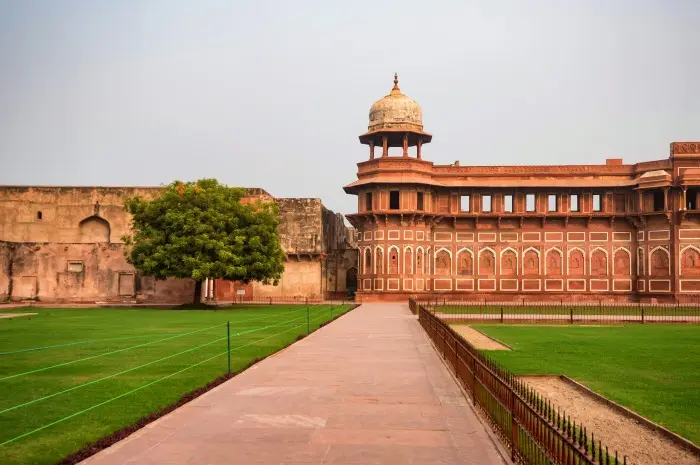Agra Fort, also known as the Red Fort of Agra, is an iconic UNESCO World Heritage Site located in the city of Agra, Uttar Pradesh, India.
This magnificent fortress stands as a witness to the rich history and architectural brilliance of the Mughal Empire.
With its grandeur and historical significance, Agra Fort attracts millions of visitors each year, making it a must-visit destination for history enthusiasts, architecture lovers, and cultural explorers.
History
The history of Agra Fort dates back to the 11th century when it was initially a simple brick fort under the Rajput rulers.
However, it was Emperor Akbar the Great, the third Mughal ruler, who transformed the fort into a colossal structure using red sandstone. Akbar laid the foundation of the fort in 1565 and completed its construction in 1573.
During the reign of Akbar’s grandson Shah Jahan, Agra Fort experienced its golden era. Shah Jahan added several exquisite structures, including the famous Diwan-i-Khas (Hall of Private Audiences) and the Musamman Burj, a stunning marble tower where he spent his final years imprisoned by his son Aurangzeb.
The fort continued to serve as the main residence of the Mughal emperors until the capital shifted to Delhi in 1638.
Why Visit Agra Fort
1. Architectural Marvel
Agra Fort showcases a seamless blend of Persian, Islamic, and Hindu architectural styles, making it a treat for architectural enthusiasts. The intricate carvings, delicate marble inlays, and impressive domes are a testament to the craftsmanship of the Mughal era.
2. Historical Significance
As a stronghold of the Mughal Empire, Agra Fort witnessed several significant events, including the rise and fall of various emperors. Exploring the fort provides a glimpse into the rich history of India and the grandeur of the Mughal dynasty.
3. Stunning Views of the Taj Mahal
Agra Fort offers breathtaking views of the Taj Mahal, which stands majestically across the Yamuna River. The strategic location of the fort provides visitors with an incredible vantage point to appreciate the iconic monument.
Location and Route
Agra Fort is conveniently situated near the city center of Agra, just 2.5 kilometers northwest of the Taj Mahal. The fort’s geographical coordinates are approximately 27.1797° N latitude and 78.0212° E longitude.
Visitors can reach Agra Fort through various means of transportation. The city of Agra is well-connected by road, rail, and air.
The nearest airport, Agra’s Kheria Airport, is approximately 12 kilometers away. Agra Fort Railway Station is another accessible option for those traveling by train. Local transportation, such as taxis, auto-rickshaws, and cycle-rickshaws, are available to reach the fort from the city center.
When to Visit
The best time to visit Agra Fort is during the winter season, between October and March when the weather is pleasant and comfortable for exploring the historical site. The temperatures during this time range from around 8°C to 25°C (46°F to 77°F). It is advisable to avoid visiting during the scorching summer months (April to June) when temperatures can soar above 40°C (104°F).
What to See
1. Diwan-i-Aam (Hall of Public Audiences)
This grand hall was where the emperor held public audiences and addressed his subjects. The hall features impressive columns and a raised platform from where the emperor would address the court.
2. Diwan-i-Khas (Hall of Private Audiences)
The Diwan-i-Khas is a remarkable structure adorned with intricate carvings and beautiful Persian inscriptions.
This hall served as a private chamber for the emperor, where he received important dignitaries and conducted meetings.
3. Musamman Burj
Located within Agra Fort, the Musamman Burj is a two-story octagonal tower made of white marble.
It offers a panoramic view of the Yamuna River and the Taj Mahal. This is where Shah Jahan spent his last years in captivity, gazing at the monument he had built for his beloved wife, Mumtaz Mahal.
4. Jahangiri Mahal
Built during the reign of Akbar, the Jahangiri Mahal is an impressive palace within the fort complex. It served as the principal zenana (women’s quarters) and exhibits a beautiful blend of Hindu and Islamic architectural elements.
Conclusion
Agra Fort stands as an architectural masterpiece, steeped in history and culture. Its grand structures, historical significance, and breathtaking views of the Taj Mahal make it an essential destination for anyone visiting Agra.
Exploring the fort allows visitors to immerse themselves in the splendor of the Mughal era and gain a deeper understanding of India’s rich heritage. Agra Fort truly stands as a testament to the enduring legacy of the Mughal Empire.
